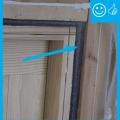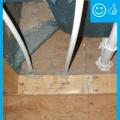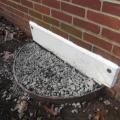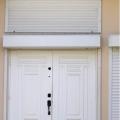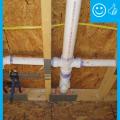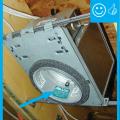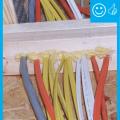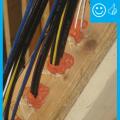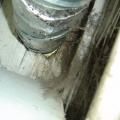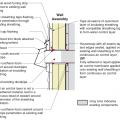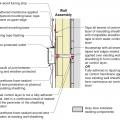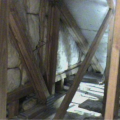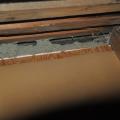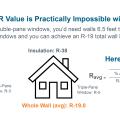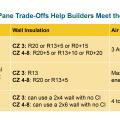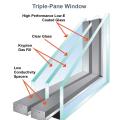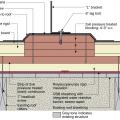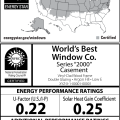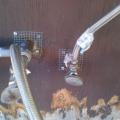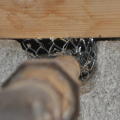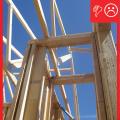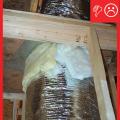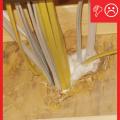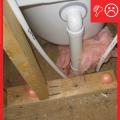Showing results 101 - 150 of 175
Right – The rough opening around window has been filled with backer-rod to air seal.
Right – This crawlspace window was completely sealed off on the inside and outside with air barrier and water-proof materials and the window well was filled in to an above-grade height to prevent bulk water from entering the crawlspace
Right – This exterior door is installed to swing out and has storm protection shutters.
Right – This ICAT recessed light is sprayed with foam to act as gasket against the drywall.
Right – Weatherstripping has been installed and remains in contact when the door is closed.
Right: Refrigerant piping is sealed where it exits the return plenum
Seal all penetrations through the band joist
Section view of duct or pipe penetration through exterior wall showing flashing and air sealing details
Section view of electric box installation in exterior wall showing flashing and air sealing details
The air tightness of the garage-to-house air barrier can be tested with a blower door kit and two manometers
The Climate Zone Map for the ENERGY STAR Window, Door, and Skylight Specification
The floor cavities under this attic kneewall are completely open to the unconditioned attic space and a prime target for wind washing
The NFRC/ENERGY STAR label provides consumers with several performance ratings for a window
The unprotected glazing in this door was broken by roof tiles dislodged by wind.
This kneewall has no top plate and the resulting gap provides a wide-open pathway for air and vapor to travel between the living space and the attic
Threshold Sweep Flashing protects the door and helps to keep out wind-driven rain.
To get an average whole-wall R value of R-19 with double-pane windows, you’d need R-330 of wall insulation; triple-pane windows can achieve an R-19 total wall R Value with R-38 of insulation
Triple-Pane windows can be used as a tradeoff for continuous wall insulation or stricter air sealing targets when showing compliance with the 2021 IECC using the UA path
Triple-pane windows use three panes of glass separated by gaps filled with krypton or argon gas, insulated spacers, and low-emissivity coatings to achieve high insulation performance
Types of window attachments include exterior attachments such as storm windows, fixed awnings, dynamic awnings, roller shutters, roller shades, and solar screens, and interior attachments such as drapes, louvered blinds, roller shades, surface applied fil
Typical installation of plywood openings protection for masonry (including CBS) building.
View-preserving interior solar screens such as these help reduce glare and solar heat gain while maintaining view to the outside
Water management detail for a solar panel rack mounting block installed in rigid foam that was installed over an existing roof
While windows typically make up only 7% of the total envelope area of a home, they are responsible for 48% of its heat loss
Whole house fans draw cool night-time air in through open windows and expel hot house air into the vented attic
Window attachments like insulated blinds, solar screens, and low-e storm windows provide many benefits including heating and cooling savings at a low first cost
Window coverings like insulated blinds, cellular shades, sun-blocking roller shades, and low-e storm windows can provide heating and cooling energy savings
Window Detail: Framed Wall with Plywood or OSB Sheathing, a WRB, and Siding (Wood, Fiber Cement, Aluminum, or Vinyl)
Wire hardware mesh is fastened with a staple gun and screws to the wall to prevent pests from entering the building through small holes and cracks
Wrong - House wrap was poorly installed, seams were not taped, and flashing tape was not installed around windows.
Wrong - Glazing failed due to windborne debris during a hurricane.
Wrong - The opening in the foundation wall around this pipe has not been sealed allowing entry for rodents and bugs
Wrong - This plumbing penetration through the foundation wall has not been sealed; the seam between the sill plate and the foundation wall is also unsealed
Wrong – Fibrous insulation is not an air barrier and cannot be used for sealing holes.
Wrong – Fibrous insulation is not an air barrier and cannot be used for sealing holes.
Wrong – Fibrous insulation is not an air barrier and cannot be used to air-seal openings.
